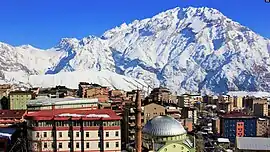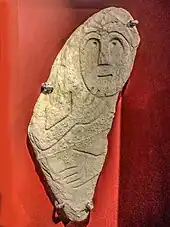Hakkâri (city)
Hakkâri (Turkish pronunciation: [hacːaːɾi]; Kurdish: Colemêrg[2]), formerly known as Julamerk,[3] (Turkish: Çölemerik) is a city and the seat of Hakkâri District in the Hakkâri Province of Turkey.[4] The city is populated by Kurds and had a population of 60,098 in 2022.[1][5]
Hakkâri | |
|---|---|
 City | |
 Hakkâri Location in Turkey | |
| Coordinates: 37.577°N 43.739°E | |
| Country | Turkey |
| Province | Hakkâri |
| District | Hakkâri |
| Population (2022)[1] | 60,098 |
| Time zone | TRT (UTC+3) |
It is located about 40 kilometres from the Iraq–Turkey border, but the distance to the nearest Iraqi border crossing (Ibrahim Khalil Border Crossing) by road is about 270 km.
Etymology
Ibn Khallikan wrote in the 13th century that the word Hakkari meant 'belonging to Hakkar', a Kurdish tribe.[6]
Neighborhoods
The city is divided into the neighborhoods of Bağlar, Berçelan, Biçer, Bulak, Dağgöl, Gazi, Halife Derviş, Karşıyaka, Keklikpınar, Kıran, Medrese, Merzan, Pehlivan, Sümbül and Yeni.[4]
History
Hubushkia
Hubushkia was an Iron Age kingdom located between the Urartian and Assyrian sphere of influence. The exact location of Hubushkia is unknown, but scholars suggests that the kingdom of Hubushkia was centred on the headwaters of the Great Zap River, in what is now Hakkâri Province in Eastern Anatolia, Turkey.[7][8]
Hakkari kurgan stelae

Thirteen Kurgan stelae, never before seen in Anatolia or the Near East, were found in 1998 in their original location at the centre of Hakkari. The stelae were carved on upright flagstone-like slabs measuring between 0.7 m to 3.10 m in height. The stones contain only one cut surface, upon which human figures are chiseled. The theme of each stele reveals the foreview of an upper human body. The legs are not represented. Eleven of the stelae depict naked warriors with daggers, spears, and axes—masculine symbols of war. They always hold a drinking vessel made of skin in both hands. Two stelae contain female figures without arms. The stelae may have been carved by different craftsmen using different techniques. Stylistic differences shift from bas relief to a more systematic linearity. The earliest stelae are in the style of bas relief while the latest ones are in a linear style. They were made during a period from the fifteenth century BC to the eleventh century BC in Hakkari. Stelae with this type of relief are not common in the ancient Near East however there are many close parallels between these and those produced by a variety of peoples from the Eurasian steppes between the third millennium BC and the eleventh century AD.[9] They are now on display in the Van Museum.
Sport
The women's football club Hakkarigücü Spor was promoted to the Women's First League to take part in the 2018–19 season after finishing the 2017–18 Second League season as runners-up.[10]
Notable people
- Evdilsemedê Babek (972–1019), Kurdish poet
- Ali Hariri (1009–1079/80), Kurdish poet
- Izz al-Din Shir (1384–1453) Famous founder of the Emirate of Hakkâri
- Çelik Gülersoy (1930–2006), Turkish lawyer of Kurdish descent
- Hacı Karay (1950–1994), Kurdish Human rights Activist
- Savaş Buldan (1961–1994), Kurdish Businessperson
- Yılmaz Erdoğan (born 1967), film actor, activist, poet
- Pervin Buldan (born 1967), Turkish politician of Kurdish origin
- Abdullah Zeydan (born 1972), Kurdish politician
Population
Population history of the municipality from 1997 to 2022:[11][1]
| Year | Pop. | ±% p.a. |
|---|---|---|
| 1997 | 57,077 | — |
| 2007 | 57,954 | +0.15% |
| 2012 | 58,584 | +0.22% |
| 2017 | 56,800 | −0.62% |
| 2022 | 60,098 | +1.14% |
Climate
Hakkâri has a hot-summer, Mediterranean-influenced humid continental climate (Köppen climate classification: Dsa, Trewartha climate classification: Dca). The winters are cold and snowy with an average of −5 °C (23 °F), while summers are hot and dry. The lowest recorded temperature was −22.7 °C (−8.86 °F) on 7 February 1997. The summer are hot and dry with an average of 25 °C (76 °F). The highest recorded temperature was 37 °C (98.6 °F) on 2 August 1991.
| Climate data for Hakkâri (1991–2020, extremes 1961–2022) | |||||||||||||
|---|---|---|---|---|---|---|---|---|---|---|---|---|---|
| Month | Jan | Feb | Mar | Apr | May | Jun | Jul | Aug | Sep | Oct | Nov | Dec | Year |
| Record high °C (°F) | 11.8 (53.2) |
12.9 (55.2) |
19.7 (67.5) |
25.0 (77.0) |
30.7 (87.3) |
34.4 (93.9) |
38.8 (101.8) |
38.0 (100.4) |
37.1 (98.8) |
29.3 (84.7) |
20.8 (69.4) |
17.5 (63.5) |
38.8 (101.8) |
| Average high °C (°F) | −0.5 (31.1) |
1.3 (34.3) |
7.0 (44.6) |
13.2 (55.8) |
19.6 (67.3) |
26.3 (79.3) |
31.1 (88.0) |
31.5 (88.7) |
26.7 (80.1) |
19.0 (66.2) |
10.0 (50.0) |
2.5 (36.5) |
15.6 (60.1) |
| Daily mean °C (°F) | −4.1 (24.6) |
−2.6 (27.3) |
2.7 (36.9) |
8.6 (47.5) |
14.4 (57.9) |
20.5 (68.9) |
25.0 (77.0) |
25.2 (77.4) |
20.7 (69.3) |
13.6 (56.5) |
5.5 (41.9) |
−1.2 (29.8) |
10.7 (51.3) |
| Average low °C (°F) | −7.5 (18.5) |
−6.2 (20.8) |
−1.2 (29.8) |
4.2 (39.6) |
9.6 (49.3) |
14.7 (58.5) |
18.7 (65.7) |
18.8 (65.8) |
14.5 (58.1) |
8.3 (46.9) |
1.3 (34.3) |
−4.6 (23.7) |
5.9 (42.6) |
| Record low °C (°F) | −23.4 (−10.1) |
−22.7 (−8.9) |
−19.0 (−2.2) |
−8.3 (17.1) |
−0.8 (30.6) |
5.0 (41.0) |
10.0 (50.0) |
9.7 (49.5) |
4.3 (39.7) |
−5.8 (21.6) |
−15.0 (5.0) |
−21.3 (−6.3) |
−23.4 (−10.1) |
| Average precipitation mm (inches) | 90.8 (3.57) |
102.3 (4.03) |
119.2 (4.69) |
119.0 (4.69) |
68.9 (2.71) |
14.5 (0.57) |
9.3 (0.37) |
5.4 (0.21) |
10.9 (0.43) |
56.2 (2.21) |
77.8 (3.06) |
102.7 (4.04) |
777.0 (30.59) |
| Average precipitation days | 10.27 | 10.13 | 12.83 | 13.03 | 12.60 | 4.27 | 2.00 | 1.27 | 2.40 | 8.70 | 8.63 | 10.40 | 96.5 |
| Mean monthly sunshine hours | 120.9 | 146.9 | 179.8 | 198.0 | 266.6 | 345.0 | 368.9 | 347.2 | 294.0 | 223.2 | 159.0 | 114.7 | 2,764.2 |
| Mean daily sunshine hours | 3.9 | 5.2 | 5.8 | 6.6 | 8.6 | 11.5 | 11.9 | 11.2 | 9.8 | 7.2 | 5.3 | 3.7 | 7.6 |
| Source: Turkish State Meteorological Service[12] | |||||||||||||
See also
References
- "Address Based Population Registration System Results". Türkiye İstatistik Kurumu (in Turkish). Retrieved 15 February 2023.
- Avcıkıran, Adem. Kürtçe Anamnez, Anamneza bi Kurmancî. p. 55.
- Coakley, James F. "Hakkari". Retrieved 28 June 2021.
- "Türkiye Mülki İdare Bölümleri Envanteri". T.C. İçişleri Bakanlığı (in Turkish). Retrieved 19 December 2022.
- Peter Alfred, Andrews; Benninghaus, Rüdiger, eds. (1989). Ethnic Groups in the Republic of Turkey. p. 214.
- Ibn Khallikan's Biographical Dictionary. Vol. 1. Translated by de Slane, William McGuckin. Paris. 1843. p. 286.
- Veli Sevin, Mystery Stelae, Archaeology, Volume 53 Number 4, (July/August 2000).
- Oscar White Muscarella (7 June 2013). Archaeology, Artifacts and Antiquities of the Ancient Near East: Sites, Cultures, and Proveniences. BRILL. pp. 385–. ISBN 978-90-04-23669-1.
- Mystery Stelae. Archaeology.org. Retrieved 2011-02-11.
- "Hakkarigücü Spor Kadın Futbol takımı sena hazırlanıyor". Habertürk (in Turkish). 20 August 2018. Retrieved 1 September 2018.
- "1997 Population Count" (PDF) (in Turkish). Turkish Statistical Institute. 1999. Archived (PDF) from the original on 30 October 2022.
- "Resmi İstatistikler: İllerimize Ait Mevism Normalleri (1991–2020)" (in Turkish). Turkish State Meteorological Service. Retrieved 3 May 2021.